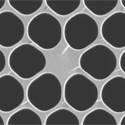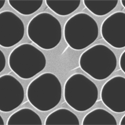No more orders, please!
Confining light to tiny regions in space enhances its interaction with matter, leading to a host of phenomena, from surface-enhanced Raman scattering on metal surfaces to nonlinear effects in optical fibers.
Writing in Physical Review Letters, Myeong Soo Kang, Andre Brenn, and Philip Russell from the Max-Planck-Institute for the Science of Light in Erlangen, Germany, demonstrate how to harness the effects of confinement to generate a nonlinear optoacoustic effect in nanostructured photonic crystal fibers. They launch two orthogonally polarized laser beams through a birefringent fiber, in a setup that allows them to tune the frequency difference between the two beams. When this frequency offset is at a resonance, the laser pair excites a tightly confined acoustic mode in the fiber core, causing the fiber to vibrate. The acoustic mode borrows its energy from the higher frequency beam, which acts as a pump signal, and eventually transfers it to the lower frequency (Stokes) beam. This transfer of energy is similar to what happens in Raman scattering, but is designed so that no higher or lower frequency modes are excited as the optical power is increased. The result is a highly selective power transfer from the pump to the Stokes signal that occurs at a unique frequency and can be efficient, in some cases.
This effect, which the authors call forward stimulated interpolarization scattering, or SIPS, may find applications in optical amplifiers, signal processing, and optical sensing. – Manolis Antonoyiannakis





